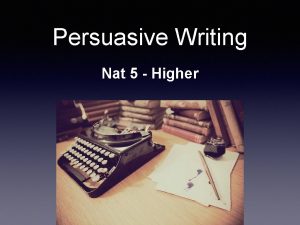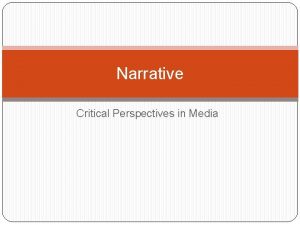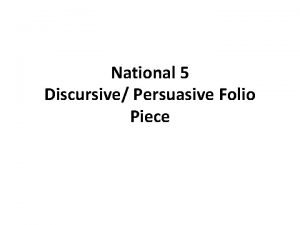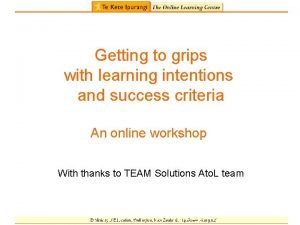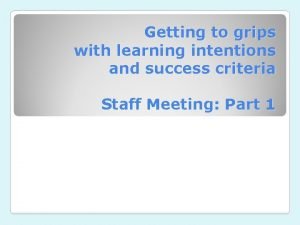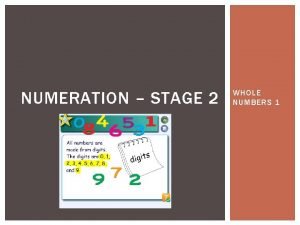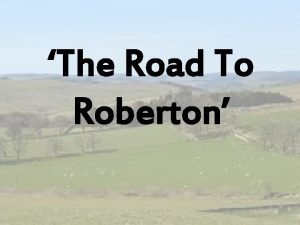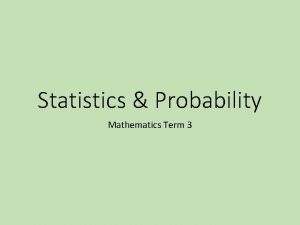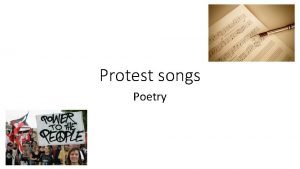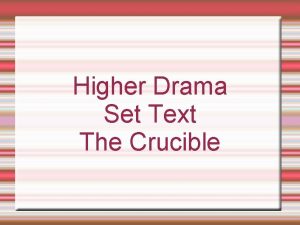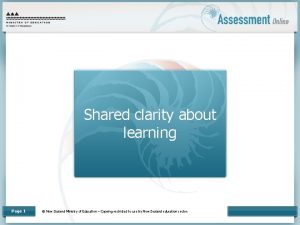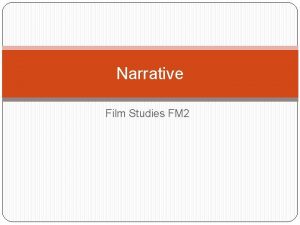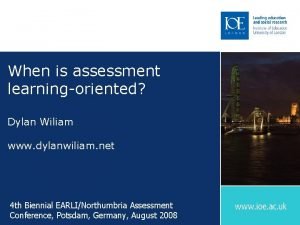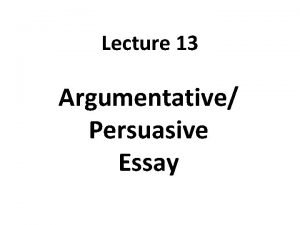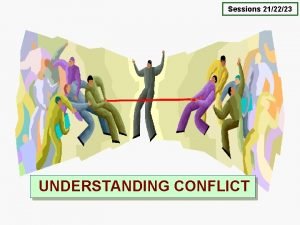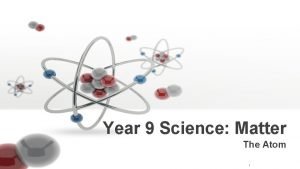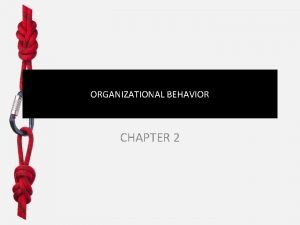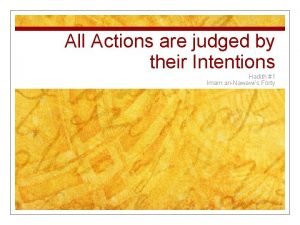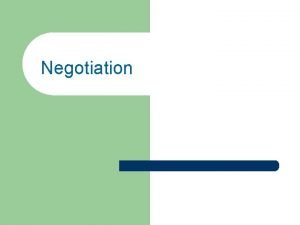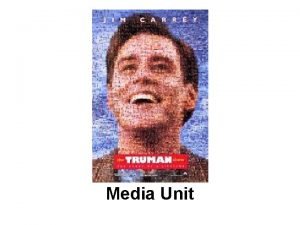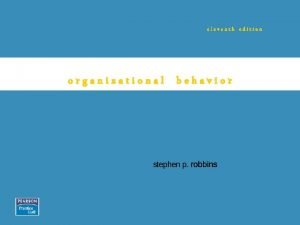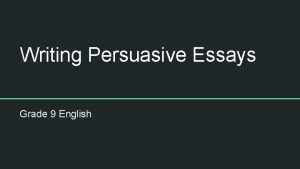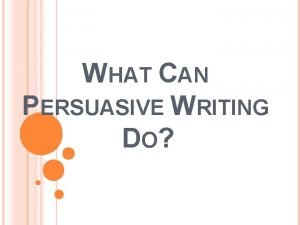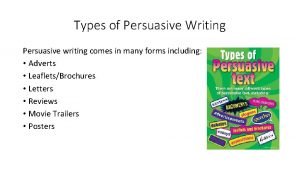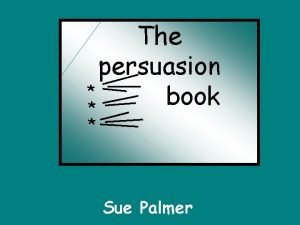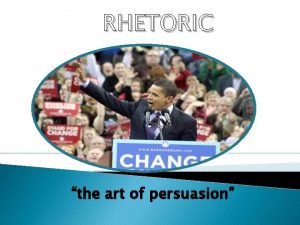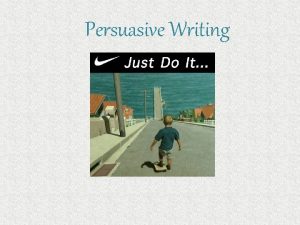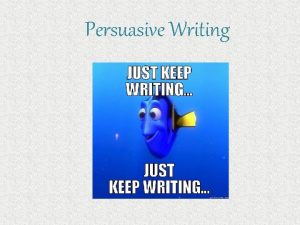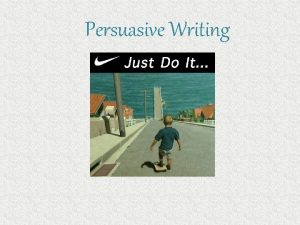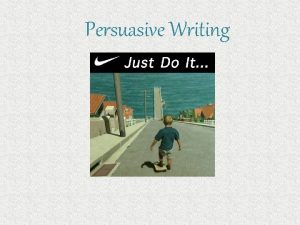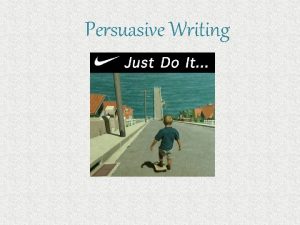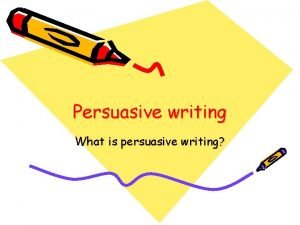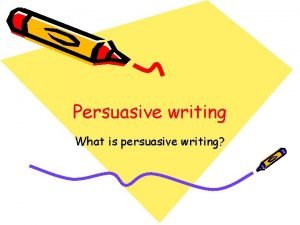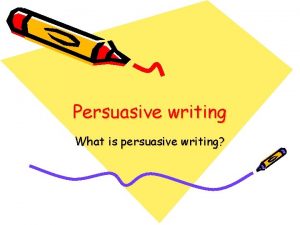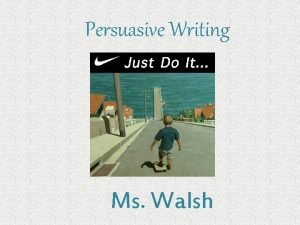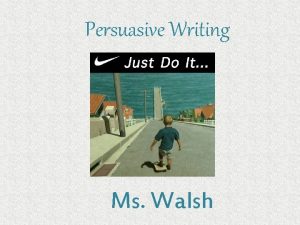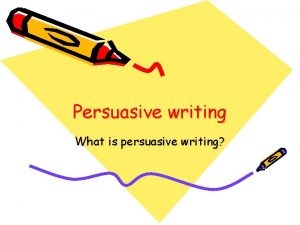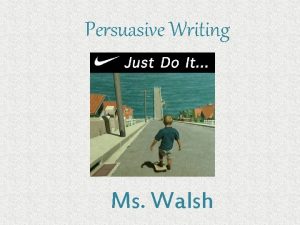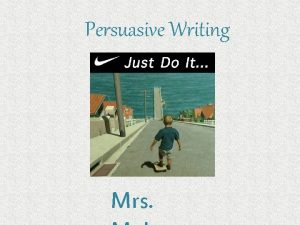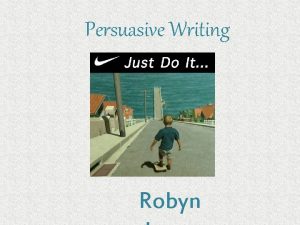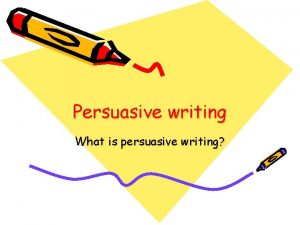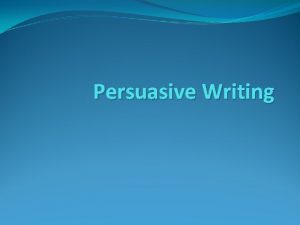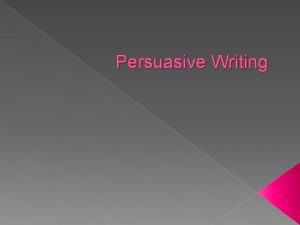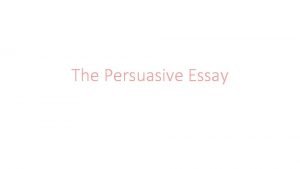Persuasive Writing Nat 5 Higher Learning Intentions To














































- Slides: 46

Persuasive Writing Nat 5 - Higher

Learning Intentions • To understand what structure is expected in a piece of persuasive writing. • To understand which techniques are used to persuade. • To consider potential topics for a persuasive piece of writing.

Lesson 1 - What is persuasive writing? Discuss: Where might we see persuasion being used?

• explores a controversial issue in depth • uses research and supporting evidence • is carefully structured • is a more emotional way of writing Argumentative Persuasive * writer remains neutral and detached from * writer’s personality and opinions are clear the topic * all sides of the argument are treated equally (unbiased) * all sides of the argument are looked at, but one side is favoured more than others (biased) * points are listed sequentially with the most * points are structured logically to build up a important points first line of argument * uses information and persuasive language * uses information to inform the reader of all to persuade the reader of the writer’s the relevant issues. opinion

Planning your piece Before you write, you need the following: • TOPIC: the issue you are writing about • STANCE: what you are actually trying to persuade the reader of • POINTS: the arguments or opinions you will put forward to support your stance

Choosing a TOPIC Your topic must be: • controversial and open to debate • topical and worth writing about now • interesting to you and the reader • original and not an overdone topic • allows you to research and develop deep knowledge and genuine insight

Overdone Topics * Social media * Technology’s negative impact on society * Size zero models * Footballer’s wages * Gun laws in America * Goal-line technology * Animal testing/cruelty * Abortion * Orcas in captivity * Euthanasia * Capital punishment * Cosmetic surgery * Reality TV/talent shows * Illegal downloading * Legalising cannabis * School uniform * Scottish independence

Original Topics Ex-rated: the BBFC is an anachronism The apostrophe’s had its day Up the Amazon: why the world’s largest retailer doesn’t deserve its bad rep Lose the loose change: it’s time to scrap the penny Poor Odds: the lottery is statesanctioned exploitation of the poor Don’t save the panda: classic overreactions to climate change Overdue: libraries must evolve to survive Suckers in love: how Twilight creates unrealistic expectations of men Time of tragedy: the ‘minute’s silence’ is being over-used and undermined. Mirror, on every wall: Disney princess culture’s negative influence on young girls Who will Avenge us? : Hollywood’s failure of female superheroes Note to selfie: the role of the selfie in the decline of youth The good fight: you can be a pacifist and still enjoy military gaming Glamazons at Glastonbury: since when were music festivals al fresco fashion shows?

Task 1 • In your groups, brainstorm some original topics. • Think about your interests or what annoys you. • Try to come up with 5 or 6 good ideas.

POINTS Some of the most common feedback given to students is: “your line of argument is weak”. This usually means the points have not been planned out. Points are the arguments or opinions you will put forward to support your stance. They should be written as brief statements when planning (not questions) Your points should flow logically, linking together, each building on the last, to lead towards your conclusion.

Example POINTS STANCE: we should get rid of the 1 p coin 1) We are an increasingly cash-less society: debit cards, ebanking, etc. 2) When we do pay with cash, we rarely have the chance to use coppers - inflation means even penny sweets don’t cost 1 p any more! 3) So coppers build up in piggy banks and pockets and are never spent - so many coins out of circulation is pointless 4) Not only pointless, but also an expensive waste: costs the Royal Mint millions to produce them every year

Task 2 • Read your group’s article and answer the following questions: 1) What is the writer’s topic and stance? 2) What are the writer’s 3 main points? 3) Does the writer oppose any counter arguments?

LESSON 3 Researching your topic

Supporting evidence This is information that backs up or emphasises your points. You should use a variety of types of evidence. Types of evidence include: * Facts * Statistics * Anecdotes, case studies, examples, illustrations * Quotations from respected authority figures or experts. * Quotations from broadsheet newspaper articles on the topic.

Referencing your sources The web links for the websites where you find your evidence should be written down in your bibliography. You should keep a note of these during the planning process as it will save you a lot of time and effort later on. You should also write down the date you accessed the information. You should set each web address like this: Author of website, Name of website, URL, [Accessed: give date]

Footnotes are used to help the reader work out where particular pieces of evidence came from. They make your piece look a lot more professional and reduce the risk of you being accused of plagiarism. On a PC (Word) On a Mac (Pages) 1) Put the cursor after the piece of evidence. 1) 2) Click the ‘Insert’ tab at the top of the page. 2) 3) Click on ‘Insert footnote’ - NOT ‘Insert endnote’ 3) 4) Paste the URL of the webpage you got that bit of evidence from. 4) Put the cursor after the piece of evidence. Click the ‘Insert’ menu at the top of the screen. Scroll down and select the ‘Footnote’ option. Paste the URL of the webpage you got that bit of evidence from.

Create a skeleton plan 1) Write your stance as a heading. 2) Write your points (in simple statements) as subheadings 3) Underneath each point, bullet point your supporting evidence This will be the bones of your essay. Once you have your skeleton plan, you’re 70% of the way there: all you need to do is flesh it out with persuasive language and rhetorical devices!

Lesson 4 Persuasive Techniques

Word choice • Word choice is the easiest way to make your writing more persuasive. • By choosing particular words, you can portray your subject in a negative or positive light. This shows your opinion/stance without having to tell the reader explicitly. Emotive language • Words designed to convey emotion to the reader, or create motion in the reader, through their strong connotations. fleeing, destroyed, defenceless, vile, cheats, frail, thug, yob, victim, tragic, sick, cruel, barbaric, savage, lonely, vulnerable, beast, immoral, struggle, hate crime, ravaged, stranglehold, historic, monumental, inspirational, liberated, innocent, adored, sanctuary, idyllic, homely, cosy, joyous. . .

Sentence Structures * should be varied to create interest and flow. * should also be used for emphasis. * can also be used for balance or to show contrast. Simple sentences and minor sentences “It is barbaric. It must be stopped. Now. ” “A face so handsome. A voice so smooth. Ah, my hero!” “Yeah. Ok. Whatever you say. ” Compound sentences using conjunctions “I have faith in our nation because history has shown that good usually triumphs over evil in these situations. ” “The evidence was unclear yet the decision went ahead. ”

Short sentence after a long one “My daughter – despite owning many dolls and books about ballerinas, many shiny and sparkly garments and other glittery, stereotypically girlish fare – would much rather build a skyscraper out of Legos or read about how to expand her game play on the coding app Hopscotch. And I, for one, couldn’t be happier about it. ” Single sentence paragraph Sentential adverbs (a single word or phrase that interrupts the sentence for emphasis) “But the weapons did not, in fact, exist. The evidence was, without doubt, a fabrication. In short, we were tricked. ”

Rhetorical Devices Imagery Use of similes, metaphors, personification. “If we are all soldiers in the war against drugs, we can force the army of drug pushers into retreat. ” Parenthesis Interrupting a sentence to insert a further explanation or aside in dashes or brackets. Usually used to add extra information which helps convey tone. Triple Statements sound more powerful when put in threes. “An increase in the numbers of policemen will lead to safer streets, safer cities and a safer society. ” Rhetorical Question A question which doesn’t require an answer as it may be implied or known to the reader.

Repetition These questions focus the reader to think about where they stand hopefully agree with the point you’re making. Use them sparingly and at a place were it is likely they will agree. “Surely displaying respect to all faiths in ‘The Land of the Free’ is the perfect retort to the intolerance, violence and limited world view of the jihadists? ” Hyperbole/Exaggeration Overstating can be effective in creating humour while illustrating flaws in the opposing argument. “While having a fleet of new and shiny massive aircraft carriers to sail around the world’s island or coastal hotspots is all well and good, we cannot have this at the expense of soldiers in Afghanistan making do with old tin trays in their Land Rovers as protection against road side bombs. ”

Lesson 5 Writing your introduction

Introduction Your intro should: * Show you can write with style. * Make it clear what your issue is and show your stance. * Show the issue is important - topical/contemporary/of the moment/affects everyone/has been ignored/or is going unnoticed/under-the-radar/deserves attention * Show it is of intense personal significance to you

Good types of intro? Provocative e. g. "It is difficult to see how anyone can approve of fox hunting. " Humorous Start by looking at the topic in a humorous way - either by mocking it or making fun of yourself. Quotation e. g. "Oscar Wilde once described fox hunting as 'The unspeakable in pursuit of the uneatable. '. " Illustration e. g. "On a glorious autumn morning a terrified, exhausted animal is savaged to death by a pack of baying dogs while a group of expensively dressed humans encourage the dogs in their bloody work. " Anecdote e. g. "I have always detested fox hunting since I was almost physically sick while watching a television film of the kill at the end of a hunt. "

What to avoid * Don’t use a rhetorical question to introduce your topic. * Don’t go into specific details about particular points or evidence keep it broad. * Don’t be wishy-washy by saying things like : ”This is a topic about which there are many different opinions on both sides. ” * Avoid the first person unless you are deliberately using a personal anecdote or conversational tone. * Don’t talk about your own essay (“In this essay I’m going to…”)

Task 1 • You are about to read 8 introductions on a variety of topics. • For each, your pair must tell me what the topic is and why the intro is effective.

Following her victorious second round match at the 2015 Australian Open tennis tournament, female tennis player Eugenie Bouchard was completing an interview when male presenter Ian Cohen demanded that she “give us a twirl”. Initially stunned by his request, she hesitated before reluctantly obeying him. Before this, Cohen had also asked Serena Williams for a twirl but did he ask Andy Murray for a twirl to show off his boxers? Even now, there is not a level playing field regarding gender. What is effective about this intro?

Picture this: a peaceful countryside landscape with luscious green fields and woodland. Then, the tranquillity is ruined by the sound of gunfire and the piercing scream of an animal in its dying breaths. This is the harsh reality of our countryside. Every day badgers’ lives are threatened due to the cull the government so imprudently enacted. Britain's MPs and population were deceived into approving a policy that could send a third of the nation’s badgers to their deaths: they were misled by the scientific case that backed the policy from day one. The same policy which Lord Robert May, a former government chief scientist, claimed simply "does not make sense". What is effective about this intro?

We share 96% of our genomes with chimpanzees. A mere 4% separates us from them on a genetic level so why are we so massively different from them? We are the only species on the planet that have the ability to not only use tools, but improve on those tools generation after generation. We have put a man on the moon, created plastics, computers, synthetic fibres and the Internet while our evolutionary cousins have contented themselves with the all-be-it impressive feat of using stones to crack open nuts. So what separates us from the animal kingdom? What gives us the ability to strive further and further away from them? Collective learning. The ability to gather and improve on information given to us by our ancestors is a gift given to us either by an evolutionary quirk or a divine being and should be treated as such. A gift. The education system here in Scotland is failing to treat this unique and aweinspiring feat with the respect it deserves. Education not only splits us from the rest of the animals, our future as a race depends on it to grow and possibly even survive. What is effective about this intro?

It’s become a familiar experience to the 21 st-century cinemagoer: that nagging feeling of deja vu in the multiplex, the sense that one is seeing the same movie over and over again. This is hardly surprising given seven of last year’s 10 highest-grossing films were either remakes, sequels or set in a pre-existing “cinematic universe”. Hollywood has become – perhaps always has been – a cultural Mobius strip, doomed to eternally travel the same path, only ever shifting its trajectory slightly; an old scratched, warped record that never plays quite the same way twice. What is effective about this intro?

Picture this. It’s the story of a family man, a man of science, a genius who fell in with the wrong crowd. He slowly descends into madness and desperation, lead by his own egotism. With one mishap after another, he becomes a monster. I’m talking, of course, about Friends and its tragic hero, Ross Geller. You may see it as a comedy, but I cannot laugh with you. To me, Friends signals a harsh embrace of anti-intellectualism in America, where a gifted and intelligent man is persecuted by his idiot compatriots. And even if you see it from my point of view, it doesn’t matter. The constant barrage of laughter from the live studio audience will remind us that our own reactions are unnecessary, redundant. What is effective about this intro?

What is it like to look at the very last of something? To contemplate the passing of a unique wonder that will soon vanish from the face of the earth? You are seeing it. Sudan is the last male northern white rhino on the planet. If he does not mate successfully soon with one of two female northern white rhinos at Ol Pejeta conservancy, there will be no more of their kind, male or female, born anywhere. And it seems a slim chance, as Sudan is getting old at 42 and breeding efforts have so far failed. Apart from these three animals there are only two other northern white rhinos in the world, both in zoos, both female. Having lost so much already, the world can’t afford to lose the white rhino. What is effective about this intro?

I don’t like white women. Whenever I say that, white women look at me like I just decapitated Taylor Swift. If I’m being honest, their reaction is part of the reason I say it. But rest assured, it’s not the only reason. I don’t like white women because I’m not particularly fond of the construct of whiteness or what it represents. I also don’t appreciate those who are complicit in my oppression and benefit from it. When I say I don’t like white women, it’s not in reference to any specific white woman. It’s a declaration that white women pose a very real threat to my existence, and I don’t have to embrace that threat with open arms. You have to earn my fondness. This goes for several other groups, obviously, but for some reason white women seem the most baffled by it. Whenever I meet a white woman who’s not baffled by it, we instantly become friends. Those are the white women I like. What is effective about this intro?

Task 1 • Write an introduction for your topic. • It should be at least 150 words long and use at least two of the techniques suggested.

Lesson 5 Writing your main body

Main paragraphs • There is no specific way of structuring your main paragraphs as the best pieces flow instinctively. • However, it’s suggested that you loosely follow the following structure: Statement of your point Explain or expand on this point Evidence to back up your point

Example from an essay entitled “Ban the Burqa in Britain? No thanks. ” Extremism aside, the veil is a garment that makes many Europeans uncomfortable , for the simple reason that it is not European. Fair enough. However, discomfort is not an adequate reason to ban something and alienate a culture, as Daisy Goodwin points out in her article ‘Seeing through the burqa ban. ’ For her, a ban cannot be justified “…simply because their adoption of a medieval style of tribal dress makes me feel uncomfortable. ” If that were the case, where would the bans stop? Facial piercings? Tattoos? Sure, criticisms of the veil can – and definitely should – be made, and under no circumstances should anyone be forced into wearing it. However, by the same token no one should be forbidden from choosing to wear it – ‘choosing’ being the operative word, as – fundamentally – it should be a choice. Britain prides itself on being a diverse and free society, and thus a ban would be utterly contradictory and – in the words of Ed Balls – “not British”.

Conclusion The conclusion is the climax of your whole argument. It’s where all of your points have been leading. You should: * draw your points together into a final overview of the situation/issue * step back from the individual details and place the whole issue back in its wider context * consider the future: What will happen? Where are we headed? What should happen? * End it with a ‘call to action’, warning or ultimatum. * End on a powerful image or analogy (comparison between one thing and another to help clarify a point) * Address the reader directly. * End with a catchy phrase, quotation or pun.

What to avoid in your conclusion Don’t just repeat the points you made in your essay. Zoom out and draw them together into a broader overview. Don’t introduce new ideas or points. Don’t be vague: “Only time will tell…we’ll have to see…” Don’t end on a question. Don’t talk about your own essay (“As I have shown in this essay…”)

Carrie Fisher and the character of Princess Leia, who Fisher confessed eventually melded into her, encapsulated the ideology of a modern woman who could think for herself and not bow to patriarchal agendas or stereotypes. The two broke the mould of feminine expectations, where Fisher, a strong champion of feminism taught young women that nothing should stop them from being themselves. Princess Leia delivered immortality to Carrie Fisher. Her passing is a monumental loss not only to cinema, but to generations of women who were taught the importance of carving their own identities, distinct from men. In short, Carrie Fisher gave our gender something we can never repay: a new hope. Why is this an effective way of ending the piece of writing?

Read a book. Learn something. Stop buying so much crap. Protect the nerds. A computer programmer from Seattle is doing more to alleviate world poverty, hunger, and disease through the Bill & Melinda Gates Foundation than any other person in America right now. Nerds create vaccines. Nerds engineer bridges and roadways. Nerds become teachers and librarians. We need those obnoxiously smart people, because they make the world a better place. We can’t have them cowering before a society that rolls their eyes at every word they say. Ross needs better friends. Why is this an effective way of ending the piece of writing?

So why do we continue with a cull: a cull which is foolish, ludicrous and senseless? To put it simply, we are too easily deceived by scientific facts that do not truly represent what we are led to believe. Not only is the government targeting the wrong species but it refuses to accept that an error was made - an error which is proving fatal for our country’s badgers. Unwilling to come to terms with the fact that there is a cheaper, more sustainable way to solve the colossal issue that is bovine Tuberculosis, they turn a blind eye to the unimaginable pain that these animals suffer due to poor execution of the cull. All we must do is make a small change in our law that will save thousands of badgers from paying the ultimate price. Why is this an effective way of ending the piece of writing?

Coming up with a title The title will be the first words the reader sees and needs to send a strong signal to them about the quality and content of your essay. A title can: Common language techniques which gain the reader’s attention: * create immediate impact * show your intelligence * make the reader think * provoke emotions such as anger, shock, disgust * be humorous * convey your opinion * make your issue clear * * * * * Alliteration Questions Rhyme Repetition Emotive language Creative punctuation Quote Unusual use of words Pun (a joke exploiting the different possible meanings of a word)

Examples Glamazons at Glastonbury An essay on how music festivals have become all about the fashion Note to selfie An essay on the selfie’s role in decline of today’s youth Grade A Rubbish An essay on the failings of Curriculum for Excellence Universities should be Universal An essay on removing tuition fees at universities Lose the loose change An essay on why we should get rid of the 1 p coin Bent Business of the Banana Trade An essay on why we should encourage fair trade Mirror, mirror, on every wall An essay on Disney princess culture’s negative influence on young girls Who will Avenge us? An essay on how Hollywood has let down female superheroes KO is not OK An essay on the negative side of boxing There Lies Sense in Defence An essay on why we need to increase the defence budget The Toupee that runs the USA An essay on the falsities of Donald Trump Rotten to the Core An essay criticising Apple’s imagination drought A Book a Day Keeps the Emojis away An essay on anti-intellectualism in today’s youth
 Nat 5 persuasive essay
Nat 5 persuasive essay Reflective phrases
Reflective phrases Act 2
Act 2 Nat 5 discursive essay topics
Nat 5 discursive essay topics Jabberwocky alliteration
Jabberwocky alliteration How to write learning intentions
How to write learning intentions Learning intentions examples
Learning intentions examples Learning intentions and success criteria examples
Learning intentions and success criteria examples Stage 2 whole number
Stage 2 whole number Basking shark poem analysis
Basking shark poem analysis Objectives of fractions
Objectives of fractions Half turn symmetry
Half turn symmetry Verb viper
Verb viper Poetry learning intentions
Poetry learning intentions Learning intentions and success criteria for mathematics
Learning intentions and success criteria for mathematics Poetry learning intentions
Poetry learning intentions Poetry learning intentions
Poetry learning intentions Features of acrostic poems
Features of acrostic poems Drama learning intentions
Drama learning intentions Learning intentions meaning
Learning intentions meaning Shared clarity about learning intentions
Shared clarity about learning intentions Narrative learning intentions
Narrative learning intentions What is assessment
What is assessment Argumentative writing and persuasive writing
Argumentative writing and persuasive writing Argumentative essay vs persuasive
Argumentative essay vs persuasive Persuasive writing examples
Persuasive writing examples Cuadro comparativo e-learning b-learning m-learning
Cuadro comparativo e-learning b-learning m-learning Creative intention
Creative intention What is a conflict of interest
What is a conflict of interest Good intentions
Good intentions Arrangement prediction intention
Arrangement prediction intention Atom intentions
Atom intentions Personal attitudes affect behavior via intentions
Personal attitudes affect behavior via intentions Undeclared intentions
Undeclared intentions Actions are judged by intentions hadith
Actions are judged by intentions hadith Thoughts and intentions of the heart
Thoughts and intentions of the heart Bargaining strategies
Bargaining strategies Character intentions
Character intentions Negotiation in organizational behavior
Negotiation in organizational behavior Vista higher learning french
Vista higher learning french Ang mga paaralan ay eksklusibo lamang para sa kanila
Ang mga paaralan ay eksklusibo lamang para sa kanila Persuasive devices
Persuasive devices Paragraph examples grade 9
Paragraph examples grade 9 I wanna iguana persuasive writing
I wanna iguana persuasive writing Forms of persuasive writing
Forms of persuasive writing Sue palmer explanation text
Sue palmer explanation text Rhetoric: the art of persuasive writing and public speaking
Rhetoric: the art of persuasive writing and public speaking
